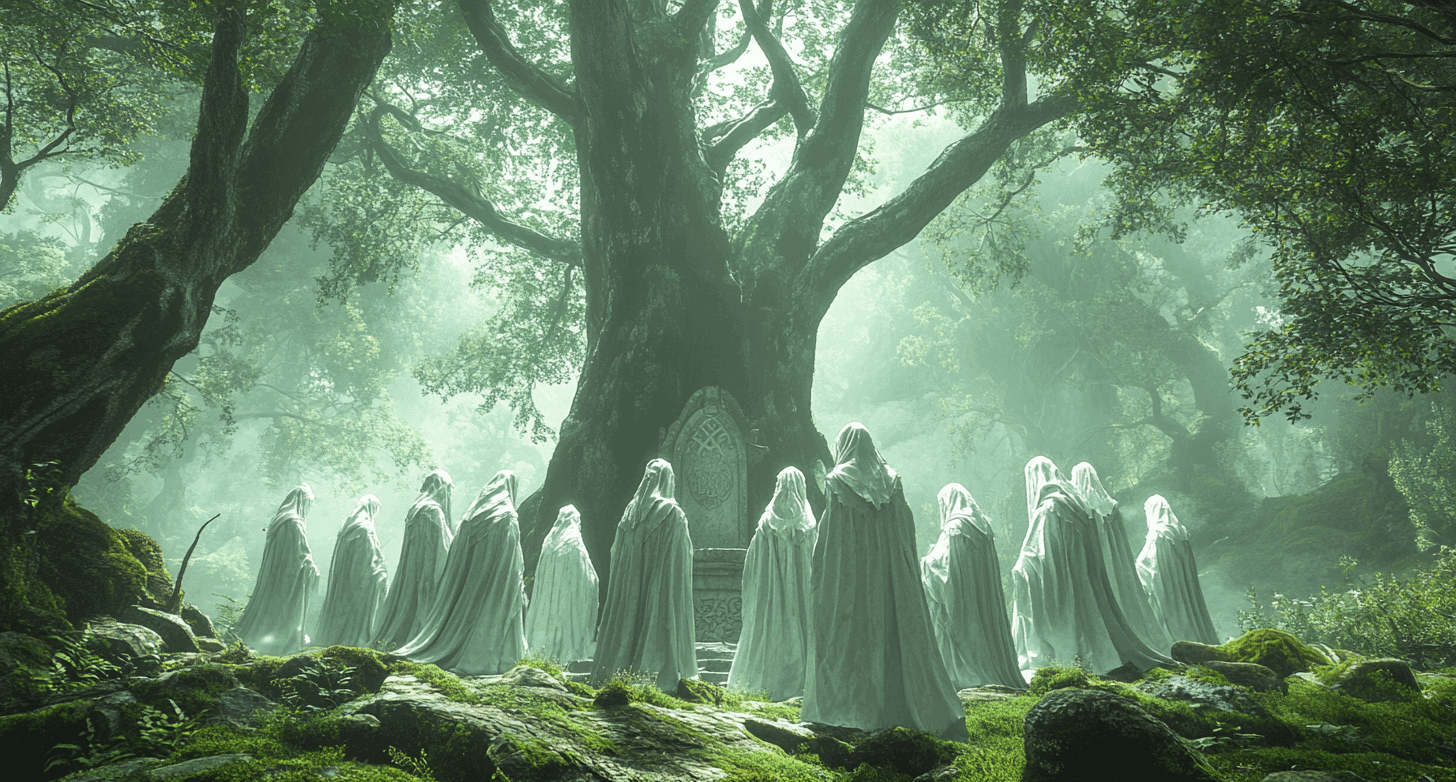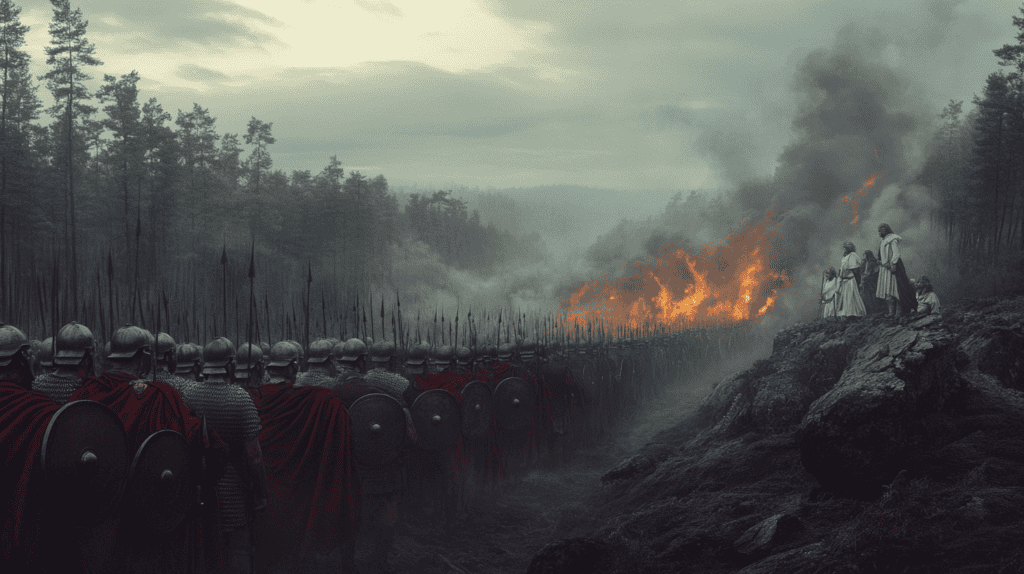
In the mist-shrouded forests and windswept hills of ancient Britain, a group of mysterious figures held sway over the Celtic tribes. These were the Druids, revered spiritual leaders and guardians of knowledge whose influence permeated every aspect of Celtic society. Their legacy continues to captivate our imagination, evoking images of white-robed figures performing arcane rituals in sacred groves.
Origins and Historical Context
The Druids emerged as a distinct class within Celtic society sometime before the 3rd century BCE. Their name may derive from a Celtic word meaning “knower of the oak tree,” reflecting their deep connection to nature. While Druidism flourished throughout the Celtic world, including Gaul (modern-day France), Britain came to be regarded as the center of Druidic learning and practice.
The earliest written accounts of the Druids come from classical Greek and Roman sources, most notably Julius Caesar’s “Commentarii de Bello Gallico.” However, these accounts must be approached with caution, as they often reflect Roman biases and political agendas. The Druids themselves left no written records, adhering to a strict oral tradition that prohibited the recording of their teachings.

Roles and Responsibilities
The Druids were far more than mere priests; they occupied a multifaceted and pivotal role in Celtic society. Their influence extended into nearly every aspect of tribal life, making them indispensable figures in the community.
Religious Leaders
At their core, Druids served as the intermediaries between the mortal world and the realm of the gods. They organized and conducted religious ceremonies, including the performance of sacrifices to honor the deities. These rituals often took place in sacred natural settings, such as oak groves and near bodies of water, reflecting the Druids’ profound reverence for the natural world.
The Druids’ spiritual practices were deeply rooted in animism, recognizing the divine presence in all aspects of nature. They held a particular reverence for trees, especially the oak, which was considered sacred. This connection to the natural world formed the foundation of their cosmology and informed their role as stewards of the land.

Keepers of Knowledge
Druids were the repositories of Celtic wisdom and lore. They underwent rigorous training, sometimes lasting up to 20 years, during which they memorized vast amounts of information. This knowledge encompassed a wide range of subjects, including history, genealogy, law, medicine, astronomy, and philosophy.
As the guardians of oral tradition, Druids were responsible for preserving and transmitting the myths, legends, and historical accounts of their people. This role was crucial in maintaining the cultural identity and cohesion of Celtic society.
Judges and Mediators
The Druids’ wisdom and authority extended into the realm of law and justice. They acted as judges in both public and private disputes, applying their knowledge of customary and divine law to maintain social order. Their judgments were highly respected, and they had the power to impose penalties, including the dreaded punishment of excommunication from religious festivals.
In times of conflict between tribes, Druids could intervene as peacemakers, using their diplomatic skills and spiritual authority to prevent warfare. This ability to mediate disputes underscored their importance in maintaining stability within and between Celtic communities.

Advisors to Kings
Druids often served as trusted counselors to tribal leaders and kings. Their broad knowledge and perceived connection to the divine made them valuable advisors on matters of governance, strategy, and diplomacy. In some cases, the Druids’ authority may have even surpassed that of the king in certain matters.
Druidic Practices and Beliefs
The spiritual world of the Druids was rich and complex, blending reverence for nature with elaborate rituals and a sophisticated understanding of the cosmos.
Nature Worship and Sacred Sites
Central to Druidic practice was the veneration of nature. Forests, especially oak groves, were considered sacred spaces where the veil between the mortal and divine worlds grew thin. The island of Anglesey (Ynys Môn) off the coast of Wales was particularly renowned as a center of Druidic activity.
Stone circles and other megalithic structures, while predating the Druids by millennia, were often incorporated into their practices. These ancient sites were seen as conduits for cosmic energies and served as gathering places for important ceremonies.

Rituals and Sacrifices
Druidic rituals were elaborate affairs, often involving the entire community. While the details of many of these ceremonies remain shrouded in mystery, we know that they included elements such as chanting, divination, and sacrifice.
The practice of sacrifice, both animal and human, has been a subject of much debate and controversy. Roman accounts describe gruesome rituals involving human victims, but these reports may have been exaggerated for political purposes. Nevertheless, archaeological evidence suggests that some form of human sacrifice did occur, albeit likely reserved for exceptional circumstances.
Belief in the Afterlife
The Druids held a strong belief in the immortality of the soul. They taught that upon death, the soul passed from one body to another, a concept similar to reincarnation. This belief in the continuity of existence beyond death profoundly influenced Celtic attitudes toward life and death, fostering a culture that did not fear mortality but saw it as a transition to another state of being.
Astronomy and Time-Keeping
The Druids possessed a sophisticated understanding of astronomy, using their knowledge of celestial movements to create complex calendars. These calendars not only marked the passage of time but also determined the timing of religious festivals and agricultural activities. The alignment of certain megalithic structures with solar and lunar events suggests that these sites may have served as astronomical observatories.

The Decline of Druidism
The arrival of the Romans in Britain marked the beginning of the end for traditional Druidism. The Roman authorities viewed the Druids as a threat to their control, recognizing the immense influence these spiritual leaders held over the Celtic population.
In 60 CE, the Roman general Gaius Suetonius Paulinus launched a devastating attack on the Druidic stronghold of Anglesey. This assault dealt a severe blow to organized Druidism in Britain, destroying sacred groves and slaughtering many Druids. The Romans justified their actions by pointing to the alleged barbaric practices of the Druids, particularly human sacrifice.
While pockets of Druidic practice may have persisted in remote areas, the systematic suppression by the Romans, coupled with the gradual Romanization of Britain, led to the decline of Druidism as a widespread and influential force. The later arrival of Christianity further eroded the old beliefs, although some aspects of Druidic lore were likely absorbed into local Christian practices.

Legacy and Modern Revival
Despite their suppression, the Druids left an indelible mark on the cultural imagination of Britain and beyond. Their legacy lived on in folklore, literature, and the enduring mystique surrounding ancient sites like Stonehenge.
In the 18th and 19th centuries, there was a resurgence of interest in Druidism, fueled by the Romantic movement’s fascination with the ancient and the mystical. This revival, while often based more on imagination than historical fact, led to the creation of neo-Druid organizations that continue to exist today.
The Druids of Celtic Britain remain enigmatic figures. What is clear, however, is the profound impact they had on Celtic society. As spiritual leaders, keepers of knowledge, and guardians of tradition, the Druids played a crucial role in shaping the cultural landscape of ancient Britain.




